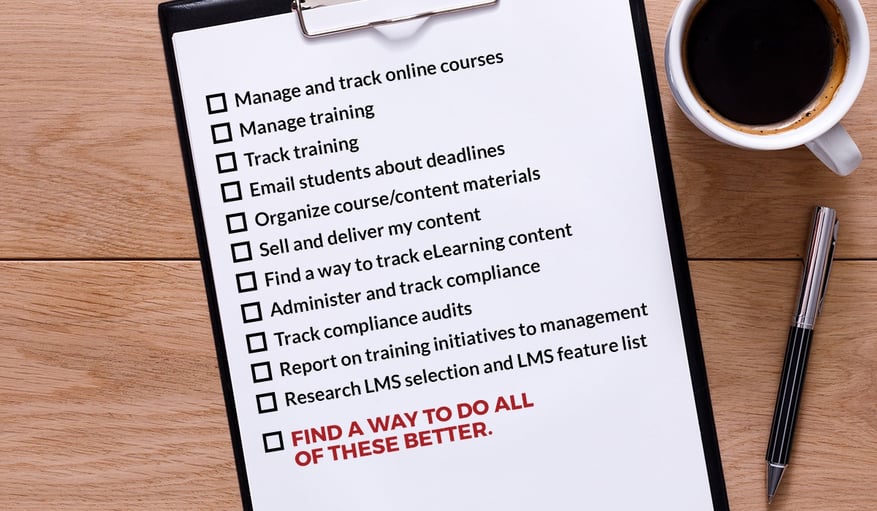You were drawn to HR and training work because you’re passionate about helping people—developing new courses for them, registering them for training, and empowering them to do their best work.
Does your to-do list look like this?

But YOU can’t do YOUR job if the length of your to-do list is mind-stutteringly long.
Unfinished tasks are piling up. Your job description has silently (malignantly) expanded overnight, while your resources and time are still the same… or wait… are they shrinking?
How is there less time when you are working more? Nights and weekends on the clock, checking email before you’re even out of bed.
This unhappy asymmetry is a symptom of the always-connected-24/7-work environment. It’s infecting the workplaces and headspaces of HR and training professionals across the country, funneling them into a dark place…
Welcome to overwhelm.
You know what really sucks here? Employees who are cognitively overloaded are dramatically less productive.
According to research from professional services firm Towers Watson, employees suffering from high stress levels are less engaged, less productive, and miss more work than those not working under intense pressure.
It’s particularly vicious for HR, because if you can't do your job, the whole organization limps to a bleeding halt.
What happened to my day?
How many times did you check your email or social media? How many things are you doing at the same time, and how many of them did you actually accomplish?
Studies show that people check their mobile devices 150 times a day. They receive 122 messages every day, and spend a quarter of their day reading and answering them. At work, 57 percent of interruptions result from the use of social media or switching among different stand-alone tools and applications.
What happened to my productivity?
The always-connected-24/7-work environment is overwhelming workers, undermining productivity, and contributing to low employee engagement, according to Deloitte’s 2014 Global Human Capital Trends report.
And it hurts the whole company: according to the Deloitte report, “This constant and frenetic level of activity also costs money, perhaps $10 million a year for mid-size companies.”
Psychiatrist Edward Hallowell, an expert on attention-deficit disorders (ADD), suggests that modern workplace stressors induce “attention deficit trait (ADT),” with symptoms similar to those of ADD.
“[ADT] is brought on by the demands on our time and attention that have exploded over the past two decades. As our minds fill with noise—feckless synaptic events signifying nothing—the brain gradually loses its capacity to attend fully and thoroughly to anything,” writes Hallowell.
What happened to my poor monkey brain?
On a good day, your prefrontal cortex is the master of ceremonies of your life, which means you’re going about the business of supporting and managing your people.
But when you’re feeling anxious and overwhelmed, your calm, capable HR cool can evaporate, and your co-workers are rudely introduced to your secret “evil-twin” personality.
In evil-twin mode, your amygdala and the lower regions of your brain are flooded with a hormone called cortisol, which primes your body for fight or flight. This is a great hormone if you’re running away from a bear, but high levels of cortisol over long periods of time can wreak havoc on your brain, hindering your capacity for rational thought.
What to do? What to do?
Go ahead and wring your hands a few times, take a deep breath and
…prioritize your tasks
What jobs are time-critical? And which ones are you most dreading? Do those first.
…break your big projects into small steps
Focus on one manageable piece at a time, and celebrate each mini-victory.
…delegate or reject tasks
Step aside for a moment and see what jobs you can delegate or officially postpone.
…get some help
Don’t suffer in silence — it’s hard to meet goals when you’re in survival mode. Talk to your managers about your priorities, resources, and job description.
If your to-do list is still hideous, it’s time to enlist some digital assistance and implement or update your Learning Management System (LMS). A good LMS can streamline your processes, offload administrative work, and eliminate repetitive tasks.
Imagine a workday where employees were synchronized with an LMS.
- Users of your system are automatically assigned training based on their jobs
- Reminder emails and reports are sent autonomously
- You are automatically tracking/applying continuing credits and certifications
- You don’t have to provide technical support to your users.
- You’re working with an experienced implementation and support team with deep corporate knowledge
You have time to do your real job! You are no longer personally signing people up for courses, sending reminders, tracking certifications—or making sure which state has what requirements.
Yes, there are a lot of systems to choose from (more than 500!) but don’t panic. We’ve got you covered.
We put together an LMS checksheet that will help you articulate the LMS feature list and requirements that would best meet your needs.
Happy de-stressing, and be sure to take it one step at a time.



 software shouldn't have a large learning curve, or, for that matter, any learning curve. It should be practically invisible. Users should be able to hop right on and begin training without being challenged by a confusing interface. The same goes for trainers: they shouldn't have to jump through hoops to create online training modules or generate the reports and documentation they need.
software shouldn't have a large learning curve, or, for that matter, any learning curve. It should be practically invisible. Users should be able to hop right on and begin training without being challenged by a confusing interface. The same goes for trainers: they shouldn't have to jump through hoops to create online training modules or generate the reports and documentation they need.